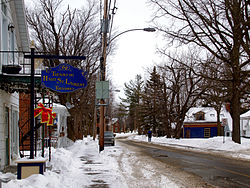
Delson is an off-island suburb of Montreal, Quebec, Canada. It is situated 8 mi/13 km SSE of Montreal within the regional county municipality of Roussillon in the administrative region of Montérégie. The population as of the Canada 2021 Census was 8,328.

Huntingdon is a small town in Huntingdon County in the Haut-Saint-Laurent Regional County Municipality and the Montérégie region of the province of Quebec, Canada. The population as of the 2021 Canadian census was 2,556. The town is 75 kilometres (47 mi) southwest of Montreal, and 15 kilometres (9.3 mi) from the border with New York State.

Mercier is a suburban town in southwestern Quebec, Canada, in the Roussillon Regional County Municipality. It is located on the Châteauguay River, southwest of Montreal. The population as of the Canada 2021 Census was 14,626.

Beauharnois—Salaberry is a former federal electoral district in Quebec, Canada, that was represented in the House of Commons of Canada from 1949 to 2015.
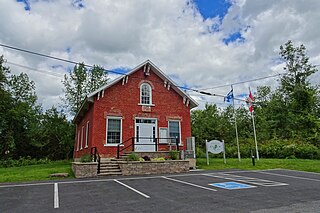
Elgin is a rural municipality in Quebec, Canada. The population as of the 2021 Canadian census was 389. It is located southwest of Huntingdon and bounded by the Trout and Chateauguay rivers and the Canada–United States border.

Hinchinbrooke is a rural community in southern Quebec, Canada, in the Châteauguay Valley, in the MRC de Le Haut-Saint-Laurent. The population as of the 2021 Canadian census was 2,187.
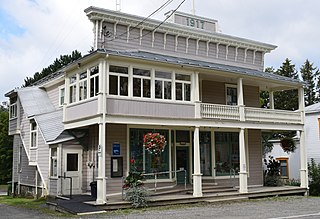
Saint-Malachie is a village of about 1,500 people in the Bellechasse Regional County Municipality, part of the Chaudière-Appalaches administrative region. The Etchemin River goes through the municipality.

Havelock is a township in Le Haut-Saint-Laurent Regional County Municipality in southern Quebec, Canada. The population as of the 2021 Canadian census was 756. Neighbouring townships include Franklin to the west, St-Chrysostome to the north and Hemmingford to the east. Havelock's southern boundary is the Canada–United States border with New York State.

The Chateauguay River is a tributary of the South Shore of the St. Lawrence River, flowing in:

Saint-Chrysostome is a municipality in south-west Quebec, Canada in the regional county municipality of Haut-Saint-Laurent in the Montérégie administrative region. The municipality was created by the amalgamation of Saint-Chrysostome village with the parish of Saint-Jean-Chrysostome on September 29, 1999. The population as of the 2021 Canadian census was 2,582.
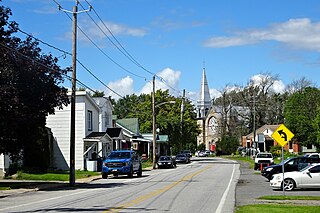
Howick is the third smallest municipality in the Canadian province of Quebec, located in Le Haut-Saint-Laurent Regional County Municipality. The population as of the 2021 Canadian census was 850. Situated along the English River in the heart of the Chateauguay Valley, it is approximately 50 minutes southwest of Montreal and 20 minutes north of the Canada–United States border.
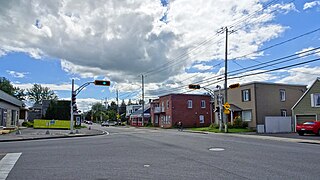
Sainte-Martine is a municipality in Beauharnois-Salaberry Regional County Municipality in the Montérégie region of Quebec, Canada. The population as of the 2021 Canadian census was 5,664. The municipality is made up of a large northern section and a small unattached southern area that was known as the municipality of Saint-Paul-de-Châteauguay until its merger with Sainte-Martine on September 9, 1999.

Très-Saint-Sacrement is a parish municipality located along the Chateauguay River in the Montérégie region of Quebec, Canada. The population as of the 2021 Canadian census was 1,189. Established in 1885, the municipality completely encloses the village of Howick, which was incorporated as a separate entity in 1915.
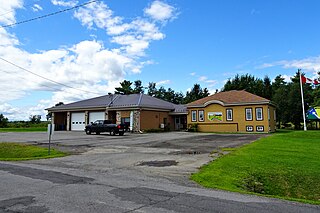
Godmanchester is a township municipality located in Le Haut-Saint-Laurent Regional County Municipality in the Montérégie region of Quebec, Canada. The population as of the 2021 Canadian census was 1,403 The southeast part of the township is mostly delineated by the Chateauguay River, while the south end borders with Franklin County, New York.

Dundee is a township municipality in Le Haut-Saint-Laurent Regional County Municipality in the Montérégie administrative region of Quebec, Canada. At the 2021 Canadian census, the population was 386. It is primarily an agricultural area consisting of dairy and grain farms.

Saint-Anicet is a municipality in Le Haut-Saint-Laurent Regional County Municipality in the Montérégie administrative region of Quebec. The population as of the Canada 2021 Census was 2,754.

Sainte-Barbe is a municipality of Quebec, located within Le Haut-Saint-Laurent Regional County Municipality in the Montérégie administrative region. The population as of the Canada 2021 Census was 1,609.
The Rivière aux Outardes Est is a tributary of the rivière aux Outardes. This cross-border river between Canada and the United States crosses:
The Rivière aux Outardes is a tributary of the Chateauguay River. It crosses the municipalities of Hinchinbrooke and Ormstown, in the Le Haut-Saint-Laurent Regional County Municipality, in the administrative region of Montérégie, in the province of Quebec, in Canada.
The La Guerre River is a tributary of the south shore of lake Saint-François which is crossed to the east by the Saint Lawrence river. This river flows through the municipalities of Sainte-Barbe and Saint-Anicet, in the Le Haut-Saint-Laurent Regional County Municipality, in the administrative region of Montérégie, in Quebec, in Canada.
